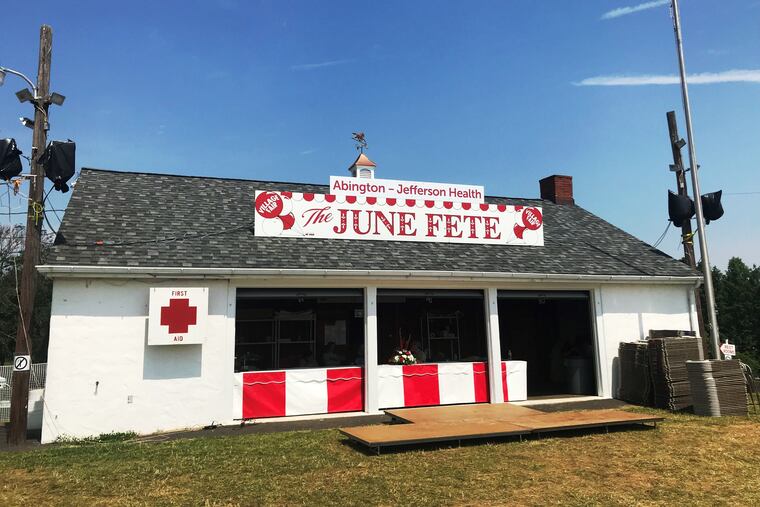Huntingdon Valley’s June Fete: Rides, funnel cake, and 100-plus years of history
Originally held at estates and country clubs by the ritzy Old York Road set, the Abington Hospital carnival/benefit has gotten more down-to-earth over the years.

The field at the intersection of Huntingdon and Edge Hill Roads in Huntingdon Valley sits empty nearly all year, the doors of a lone white barn locked. All is quiet until June arrives. That’s when, for a fleeting week, a sea of red-and-white tent tops overtakes the grassy 40 acres of land.
Hundreds of volunteers flock to these grounds to set up the dozen or so candy cane-striped booths for June Fete, one of this Montgomery County community’s largest annual events. The country fair returns this weekend, June 7 through 9. Starting Friday, amid the lush, spring-green horizons, this field plays host to kids strapped in for dragon rides, couples taking in views atop a lit-up Ferris wheel, thrill-seekers flipping upside down in the stomach-dropping Zipper, and families enjoying fresh-fried funnel cake.
June Fete looks comparable to any carnival, perhaps with a little more surrounding wildlife. But look past the rides, food, and games and you’ll see years and years of history — all centered on a do-good mission to raise money for the local hospital.
Curated by the Abington Health Foundation Women’s Board, the June Fete has served the nearby Abington Hospital (now affiliated with Jefferson Health) for over a century. The first official benefit, in 1913, raised $1,200, collected in a tin box, according to a 1934 remembrance in The Inquirer. Last year alone, the fair raised $150,000.
“There was a real need for a local hospital at the time [in 1912] and a huge community push to make sure it came to life,” explains grounds chair Deborah Gates. “A bunch of women — mainly wives of the trustees — got together and started hosting garden parties at all of the different estates, and the fund-raiser became an annual tradition.”
Far from the family-oriented fairs of today, early June Fetes were socialite affairs, set against stately backdrops like John Wanamaker’s Lindenhurst mansion, the exclusive Latham Park development, and the sprawling grounds of Huntingdon Valley Country Club. Picture English-inspired gardens and manicured lawns scattered with games like croquet. Men and women, dressed to the nines, would roll up in coaches or newfangled horseless carriages, ready to enjoy afternoon tea on the terrace.
A 1921 article from The Inquirer called out highlights: “a typical dairy farm, featuring picturesque milkmaids, with shining pails”; “a baby show,” supplemented by an area where nurses examined babies; and an auction with “novelties of all varieties ... perhaps the most original being a permanent wave” donated by Mrs. William W. Elkins. Later auctions included a pedigreed Scotch terrier puppy, a Ford car (also from Mrs. Elkins), and an evening gown.
Despite the varied attractions, couture clothing quickly became the anchor of the benefit.
“It was the fashion show that gained June Fete national notoriety,” Gates says. “Designers from New York would come, and debutantes of the area would act as their models. Advertising for the show ran as trailers before movies in theaters across the entire country.”
In 1921, the “June Fete dress” was introduced. Each year, a new design was released and sold at the fair, becoming a staple fund-raising item for decades — until production costs discontinued the tradition in the 1960s.
A pony show was added in 1922, and a horse show the year after that; both remain prime parts of today’s fair. Jill Kyle, Abington Health Foundation’s chief development officer, describes June Fete’s Horse and Pony Show as a mini version of the Devon Horse Show. The two always fall one week a part.
In 1955, a community member donated the parcel of land at Huntingdon and Edge Hill Roads, near Pennypack Creek, to the AHF Women’s Board. The June Fete has resided there ever since.
“That’s part of what makes this special," Kyle says. “It’s on this beautiful farmland that gives this a truly country-fair feel, as opposed to a lot of these other events that come and take over parking lots.”
While many of the earlier traditions have become relics of the past — the antique auction, the lobster pot booth, the signature punch served out of a giant silver bowl, and the June Fete cookbook (three editions were published) — the same community-rooted atmosphere still holds strong.
Rides have been a staple of the event since the fair found its permanent home, with the same New Jersey-based company, Skelly’s Amusements, operating them for the past 40 years. Newer amusements, like the sparkly orange Gravitron spaceship, are added every few years.
These days, the Friday night fireworks (lighting up skies around 9:15 p.m.) are the fair’s main event, packing the grounds every year. It’s followed on Saturday by the Horse and Pony Show (7 a.m. to dusk). There are also magic shows, daily live music, a mini golf course, and BMX stunt performances, along with Barnyard Bingo (Sunday, 2:30 p.m.), one of the more peculiar games.
“There’s a bingo board laid out on the grass, and we let a pony out to roam around on the numbered squares,” Gates explains. “Whichever square it picks to do its business on, that ticket holder wins a prize.”
The entire event — from setup to breakdown — comes together via a cheerful crew of volunteers who donate their time. It’s the way it’s always been.
“People really value Abington [Hospital] and the services it brings to such a large area,” says Marsha Gates, Deborah Gates’ mother-in-law and the June Fete’s grounds supervisor.
Marsha, 76, was born at the hospital and has volunteered on and off since she was a kid. Today, her sons also volunteer, as well as her grandchildren. Her family is among several multigenerational groups who pitch in each year.
“We’re raising money,” she says, “but we end up developing long-term friendships, too.”